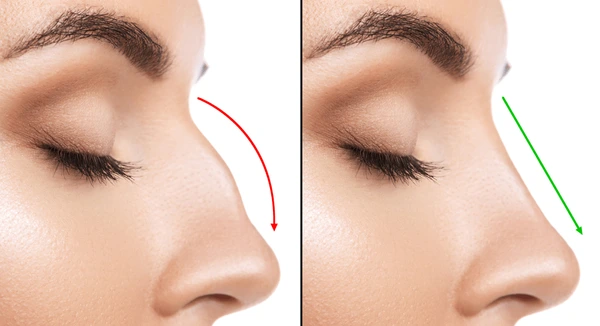Non-surgical nose jobs with fillers offer a fresh alternative to traditional rhinoplasty. Unlike surgical procedures, these treatments provide immediate results without the long recovery time. Many people want to enhance their appearance but hesitate at the thought of surgery. Fillers can reshape your nose, smooth out bumps, and create a more balanced look—all in a quick office visit.
This option is less invasive and often more affordable than going under the knife. With minimal discomfort and no general anesthesia required, it’s an appealing choice for those seeking subtle changes. Discover how non-surgical nose jobs can boost your confidence without the hassle of surgery.
Key Takeaways
-
Non-surgical nose jobs using fillers can reshape your nose without the need for invasive surgery, making it a popular choice for many.
-
Proper pre-treatment preparation, including consultation with a qualified professional, is crucial for achieving the best results and ensuring safety.
-
The procedure involves injecting fillers in specific areas to enhance the nose’s shape and can typically be completed in under an hour.
-
Post-treatment care is important; follow your provider’s tips to minimize swelling and ensure optimal healing.
-
Consider the pros and cons of fillers versus surgery; while fillers are less invasive, they may require touch-ups over time.
-
Always discuss safety and risks with your provider to make an informed decision about whether a non-surgical nose job is right for you.
Understanding Non-Surgical Nose Jobs
Definition
Nonsurgical rhinoplasty is a cosmetic procedure. It uses dermal fillers to reshape the nose. This technique enhances features without the need for surgery. Many people choose this option for its convenience and minimal downtime.
Temporary Results
The results of nonsurgical nose jobs are temporary. They typically last between six months to two years. The duration depends on the type of filler used and individual factors. Patients may require follow-up treatments to maintain their desired look.
Popularity
Nonsurgical rhinoplasty has gained popularity. Many consider it a safer alternative to surgical rhinoplasty. It involves less risk and a shorter recovery time. Patients appreciate the ability to see immediate changes without anesthesia.
Benefits
-
Quick Procedure: Nonsurgical treatments take about 15 to 30 minutes.
-
Minimal Downtime: Most individuals return to normal activities right away.
-
Adjustable Outcomes: Fillers can be added or removed if needed.
-
Lower Cost: Generally, nonsurgical options are more affordable than surgical procedures.
Risks and Considerations
While nonsurgical rhinoplasty is generally safe, some risks exist. Allergic reactions to fillers can occur. Bruising and swelling may also happen after the procedure. It’s important to consult with a qualified professional before undergoing treatment.
Comparison with Surgical Options
Surgical nose jobs involve more extensive procedures. They require anesthesia, longer recovery times, and higher costs. Surgical rhinoplasty offers permanent results but comes with greater risks. Nonsurgical options appeal to those seeking less invasive solutions.
Who Should Consider It?
Individuals looking for subtle changes may benefit from nonsurgical rhinoplasty treatments. Those who want to avoid surgery or have concerns about recovery should consider this option. It’s ideal for people who wish to enhance their appearance without long-term commitment.
How Fillers Reshape the Nose
Volume Addition
Nose fillers play a crucial role in reshaping the nose. They add volume and create a more defined contour. This process is often referred to as liquid rhinoplasty. Instead of traditional rhinoplasty, which requires surgery, fillers provide a non-invasive option.
Dermal fillers can enhance specific areas of the nose. For example, they can lift the tip or smooth the bridge. The result is a more balanced appearance. Many patients prefer this method because it requires little downtime.
Smoothing Irregularities
Fillers also help address rhinoplasty irregularities. Many people have bumps or asymmetries on their noses. These issues can occur naturally or after previous rhinoplasty procedures. Injectable rhinoplasty allows for quick fixes.
The filler can fill in depressions or bumps. This creates a smoother surface overall. Patients appreciate the immediate results without needing extensive recovery time.
Common Ingredients
Hyaluronic acid is a common ingredient in nose fillers. It is a substance that occurs naturally in the body. Hyaluronic acid helps retain moisture and adds volume to the skin.
This ingredient is safe and effective for facial injections. It provides a natural look and feel to the nose. Many practitioners choose hyaluronic acid for its versatility and low risk of complications.
Procedure Overview
During the procedure, a trained professional injects the filler into specific areas of the nose. The process typically takes less than an hour. Patients often report minimal discomfort during treatment.
Afterward, there may be slight swelling or bruising, but these effects usually fade quickly. Results can last anywhere from six months to two years, depending on the type of filler used.
Revision Options
e individuals may seek revision rhinoplasty surgery after fillers. This is especially true if they want more permanent changes or if they are unhappy with previous results. Fillers can serve as a temporary solution while considering surgical options.
Patients should consult with professionals who have rhinoplasty training to discuss their goals and expectations.
Pre-Treatment Preparation
Discuss Goals
Patients must discuss their cosmetic goals with a healthcare provider. This conversation is crucial for understanding what can be achieved with fillers. Providers can offer insights on realistic outcomes based on individual facial structures. They can also guide patients in choosing the right type of filler for their needs.
During this discussion, patients should express their desires clearly. Specific requests help providers tailor the treatment plan. Understanding the limitations and possibilities of fillers is essential. This ensures that expectations align with what the procedure can deliver.
Photographic Assessment
Providers often recommend taking pre-procedure photographs. These images serve as a baseline to assess changes post-treatment. They allow both the patient and provider to visualize the expected results.
Photographs also help track improvements over time. Patients can compare before and after images to see the effects of the fillers. This visual documentation can enhance satisfaction with the results. It provides a clear reference for future treatments if needed.
Avoid Blood Thinners
To minimize bruising risks, patients should avoid blood thinners before the procedure. Common blood thinners include aspirin, ibuprofen, and certain herbal supplements. Stopping these medications at least one week prior is advisable.
Patients should consult their healthcare provider about any medications they take regularly. This discussion helps determine which ones may need to be paused before treatment.
Reducing bruising enhances recovery and improves overall satisfaction with the results. Patients who follow these guidelines often experience smoother recovery times.
Skin Condition
Providers may evaluate the skin condition before treatment as well. Healthy skin responds better to fillers and produces more satisfying results. Patients should inform their provider of any skin issues or allergies.
For optimal results, patients might need to prepare their skin in advance. This could involve skincare routines that promote skin health. A well-prepared skin surface enhances filler application and longevity.
Hydration and Nutrition
Staying hydrated before the procedure is important too. Drinking plenty of water helps maintain skin elasticity and overall health. Proper nutrition supports healing after the treatment as well.
Patients should focus on consuming a balanced diet rich in vitamins and minerals leading up to their appointment. Foods high in vitamin C, for example, can support skin health and healing.
Step-by-Step Procedure
Initial Consultation
The process starts with an initial consultation. A qualified practitioner evaluates the nose and discusses goals. They assess facial structure and skin type. This step is crucial for achieving the desired outcome.
Preparation
After the consultation, preparation begins. The practitioner cleans the area around the nose. They may apply a topical numbing cream to minimize discomfort. This preparation ensures a smoother procedure.
Injection Process
The injection process follows preparation. Practitioners use a fine needle to inject fillers beneath the skin. They typically target specific areas for better contouring. Common areas include the bridge and tip of the nose.
During the procedure, patients can expect minimal discomfort. The entire process usually takes under 45 minutes. Many people find it quick and efficient.
Practitioners often use hyaluronic acid-based fillers. These fillers provide volume and shape without surgery. Results appear immediately after injection. Patients can see changes right away.

Immediate Effects
Visible changes occur almost instantly post-injection. The nose appears more defined and balanced. Swelling may happen but usually subsides quickly. Most patients return to normal activities the same day.
Follow-Up Care
Follow-up care is essential for optimal results. Practitioners advise avoiding strenuous activities for 24 hours. This helps reduce swelling and bruising.
Patients should also avoid touching or massaging the area for a few days. This precaution prevents displacement of the filler.
Side Effects
e side effects may occur after the procedure. Common issues include swelling, bruising, or redness at injection sites. These effects are generally mild and temporary.
Serious complications are rare but can happen. Patients should contact their practitioner if they notice unusual symptoms, such as severe pain or prolonged swelling.
Longevity of Results
Results from non-surgical nose jobs with fillers last between six months to two years. The longevity depends on factors like filler type and individual metabolism.
Patients may need touch-ups to maintain their desired look over time. Regular consultations help manage expectations and plan future treatments.
Post-Treatment Care and Tips
Monitor Side Effects
Patients should closely watch for minor side effects after a non-surgical nose job. Common reactions include redness and swelling around the injection sites. These symptoms usually resolve within a few hours to a couple of days.
If redness or swelling persists beyond this timeframe, it is crucial to consult with the provider. They can assess whether these reactions are part of normal healing or if further action is needed.
Avoid Strenuous Activities
Strenuous activities should be avoided immediately after the procedure. High-impact exercises can increase blood flow to the face, which may worsen swelling or bruising. It is best to rest for at least 24 hours post-treatment.
Activities like running, weightlifting, or intense sports can lead to complications. Patients should focus on gentle movements during this recovery period.
Follow Up with Provider
Following up with the provider is essential if unusual symptoms occur. Symptoms such as severe pain, excessive bruising, or noticeable lumps may indicate complications. Contact the provider promptly to discuss any concerns.
Providers often schedule follow-up appointments to evaluate results and address questions. Keeping these appointments helps ensure that everything heals correctly.
Hydration and Skin Care
Staying hydrated supports overall recovery. Drinking plenty of water aids in skin health and reduces potential swelling.
Gentle skin care is also important. Avoid harsh products or treatments for at least a week after the procedure. This includes avoiding facials, chemical peels, and exfoliating treatments.
Cold Compresses
Using cold compresses can help manage swelling and discomfort. Applying a clean, cold cloth to the area for 10-15 minutes can provide relief. This method works well in the first few hours after treatment.
Be cautious not to apply ice directly to the skin. Wrap ice packs in a cloth to prevent frostbite.
Avoid Makeup
Makeup should be avoided for at least 24 hours post-treatment. The skin needs time to breathe and heal without additional products that could cause irritation.
After 24 hours, patients can resume their normal makeup routine but should choose gentle products. This helps maintain healthy skin while allowing for natural healing.
Comparing Surgery and Fillers
Non-Invasive Nature
Dermal fillers offer a non-invasive option for altering the nose. Unlike surgical rhinoplasty, which involves incisions and anesthesia, injectable filler treatment is simple and quick. The procedure typically takes around 15 to 30 minutes. Patients can often return to their daily routines immediately after.
The non-invasive nature of fillers makes them appealing. Many people prefer this method because it avoids the risks associated with surgery. For example, surgical procedures can lead to complications such as infections or scarring. Fillers do not carry these same risks.
Reversibility
Another key difference lies in the reversibility of dermal fillers compared to surgical changes. Filler treatments use substances like hyaluronic acid, which the body gradually absorbs over time. If a patient dislikes the results, they can opt for additional treatments or let the filler dissolve naturally.
Surgery, however, creates permanent changes to the nose’s structure. Once a person undergoes rhinoplasty, those alterations are usually irreversible. This permanence can be daunting for some individuals. They may worry about dissatisfaction with their new appearance.
Recovery Time
Recovery time is another area where fillers shine. Surgical rhinoplasty requires significant downtime. Patients may experience swelling and bruising for weeks following surgery. Full recovery can take several months before final results become visible.
In contrast, nonsurgical options like injectable fillers require little to no recovery time. Most patients experience minor swelling or redness at the injection sites, but these effects usually resolve within hours to days. Many people feel comfortable resuming their normal activities right away.
Cost Considerations
Cost is an important factor in deciding between these two options. Dermal filler treatments generally cost less than surgical procedures. While prices vary based on location and provider expertise, fillers can be more budget-friendly for those seeking cosmetic enhancements.
Surgery often involves additional costs such as anesthesia fees and facility charges. These expenses can add up quickly, making surgery a significant financial commitment.
Final Thoughts
Choosing between dermal fillers and surgical rhinoplasty requires careful consideration. Fillers provide a non-invasive solution that allows for reversible changes without extensive recovery time. Surgical options create lasting results but come with higher risks and longer recovery periods.
Safety and Risks Consideration
Licensed Professionals
People must choose a licensed professional for non-surgical nose jobs with fillers. A qualified practitioner has the training to perform this procedure safely. They understand facial anatomy and know how to avoid complications. Checking credentials is essential. Look for board-certified dermatologists or plastic surgeons who specialize in injectables.
Potential Complications
While generally safe, non-surgical nose jobs can have risks. Complications may include vascular issues. These occur when filler accidentally enters a blood vessel. This can lead to tissue damage or necrosis. Vision problems are also possible if the filler blocks blood flow to the eye area. Other complications include swelling, bruising, and infection at the injection site.
Safety Profile
Despite these risks, non-surgical nose jobs often have a good safety profile. When performed correctly, the procedure is effective and low-risk. Many people report satisfaction with their results. Proper technique minimizes complications. Following aftercare instructions also helps ensure safety.
Importance of Consultation
Consultation is a crucial step before getting fillers. During this meeting, patients discuss their goals and medical history. Practitioners assess whether they are suitable candidates for the procedure. This evaluation helps identify any potential risks based on individual health factors.
Aftercare Guidelines
After receiving fillers, following aftercare guidelines is vital for safety. Patients should avoid strenuous activities for 24 hours post-treatment. Staying upright can help reduce swelling and bruising. Ice packs may also provide comfort and minimize inflammation.
Monitoring Results
Monitoring results after the procedure is important. People should be aware of any unusual symptoms, such as significant pain or changes in vision. Reporting these issues to the practitioner immediately can prevent further complications.
Real-Life Experiences
Many individuals share positive experiences with non-surgical nose jobs. They appreciate the quick recovery time compared to surgical options. Some report feeling more confident about their appearance without undergoing invasive surgery.
Duration and Effectiveness
Results Duration
Results from non-surgical nose jobs with fillers typically last up to six months. After this period, the body gradually absorbs the filler. The effects can vary based on several factors.
Filler Types
Different types of fillers have different longevity. For instance, hyaluronic acid fillers often last shorter than other options like calcium hydroxylapatite. Individual responses also play a significant role. Factors such as skin type, age, and lifestyle can affect how long results last.
Repeat Treatments
To maintain desired results, repeat treatments are necessary. Many patients opt for touch-ups every six months. This keeps the nose looking fresh and defined. Regular maintenance helps avoid noticeable changes over time.
Side Effects
While non-surgical nose jobs are generally safe, side effects can occur. Common issues include swelling and bruising at the injection site. These effects usually resolve within a few days. Rarely, more serious complications can happen. Infections or allergic reactions can occur but are uncommon.
Emotional Impact
Many individuals report positive emotional effects after their procedure. Improved self-esteem is a common outcome. Feeling more confident about one’s appearance can lead to greater social interactions.
Evaluating the Worth of Treatment
Personal Goals
Assessing personal cosmetic goals is crucial before deciding on non-surgical nose jobs. People should think about what they want to achieve. Do they seek a subtle enhancement or a more significant change? Understanding personal expectations helps in making an informed choice.
e individuals desire a straighter nose, while others prefer to reduce bumps. Each goal requires different approaches. Clear communication with a provider is essential. This ensures that both parties are on the same page regarding desired outcomes.
Temporary Changes
Weighing the benefits of temporary changes is important. Non-surgical nose jobs offer immediate results without long-term commitment. Fillers can enhance the shape and contour of the nose quickly. However, these results last only six to twelve months.
People must consider if they want short-term changes or if they need structural alterations. For those seeking permanent solutions, fillers may not be sufficient. Surgery might be necessary for more dramatic transformations.
Cost-Effectiveness
Cost-effectiveness plays a significant role in decision-making. Non-surgical options tend to be less expensive than surgical procedures. The average cost of fillers ranges from $500 to $1,500 per session. In contrast, surgical rhinoplasty costs between $5,000 and $15,000.
Patients should evaluate their budgets and financial situations. They must also factor in the frequency of filler treatments over time. While fillers are cheaper upfront, repeated sessions add up.
Risks and Considerations
Potential risks exist with any cosmetic treatment. Side effects from fillers can include swelling, bruising, or allergic reactions. Understanding these risks is vital before proceeding with treatment.
Patients should also consider their health history and any allergies they may have. Consulting with a qualified professional provides insights into what to expect. A thorough consultation can help address concerns and clarify doubts.
Long-Term Commitment
Long-term commitment is another aspect to ponder. Non-surgical options require maintenance for continued results. Patients must schedule follow-up appointments regularly for touch-ups.
In contrast, surgical options often provide lasting changes after recovery. Those considering surgery should prepare for a longer healing process and potential complications.
Observações Finais
Non-surgical nose jobs with fillers offer a fantastic way to enhance your appearance without the commitment of surgery. You’ve learned about the benefits, procedures, and care involved. The results can be impressive, giving you a boost in confidence. Safety is key, so always consult with a qualified professional.
If you’re considering this treatment, weigh your options carefully. Research and choose an expert who understands your needs. A well-done filler can transform your look while keeping things natural. Ready to take the plunge? Explore your options today and get that nose you’ve always wanted!
Frequently Asked Questions
What is a non-surgical nose job?
A non-surgical nose job uses dermal fillers to enhance the shape and symmetry of the nose without invasive surgery. It’s a quick, minimally painful procedure with immediate results.
How long do the effects of fillers last?
The effects of fillers typically last between 6 to 18 months, depending on the type of filler used and individual factors like metabolism and lifestyle.
Is there any downtime after the procedure?
Most patients experience minimal downtime. You may have slight swelling or bruising, but these usually subside within a few days, allowing you to resume normal activities quickly.
Are non-surgical nose jobs safe?
Yes, when performed by a qualified professional, non-surgical nose jobs are generally safe. However, as with any medical procedure, there are risks involved, including allergic reactions or asymmetry.
Can anyone get a non-surgical nose job?
While many people are candidates for this treatment, those with certain medical conditions or allergies may not be suitable. A consultation with a qualified practitioner is essential to determine eligibility.
How much does a non-surgical nose job cost?
The cost varies widely based on location, provider expertise, and the amount of filler used. Generally, prices range from $600 to $1,500 per session.
What should I expect during the consultation?
During your consultation, the practitioner will evaluate your facial structure, discuss your goals, and explain the procedure. This is also an opportunity to address any concerns or questions you may have.





